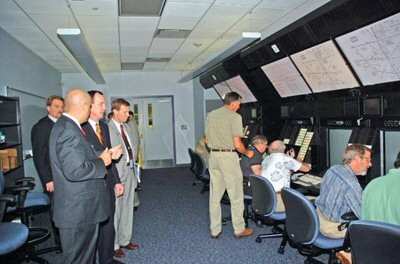No Room On The Radio?
 According to a recent missive from
NATCA, air traffic controllers at the Atlanta Air Route Traffic
Control Center (ZTL) are experiencing a worsening technical problem
with the radio frequencies used to communicate with pilots in their
airspace, creating a 'maddening challenge that is steadily becoming
a safety issue.'
According to a recent missive from
NATCA, air traffic controllers at the Atlanta Air Route Traffic
Control Center (ZTL) are experiencing a worsening technical problem
with the radio frequencies used to communicate with pilots in their
airspace, creating a 'maddening challenge that is steadily becoming
a safety issue.'
NATCA claims that it’s a five-year-old problem, and that
controllers say the troubles have gotten much worse in the last
four months and it is cause for deep concern.
NATCA Statement
Important arrival frequencies into the Hartsfield-Jackson
Atlanta International Airport have been severely degraded.
Controllers are reporting frequency failures on the southwest side
of the Atlanta metropolitan area at the worst possible times
– during thunderstorms, when many aircraft are in holding
patterns and deviating around the convective weather. The other
problem frequencies are on the northeast side of Atlanta, and
controllers have been complaining about this one for over five
years because they can’t communicate to any aircraft in the
holding pattern without going to a backup frequency.
The northeast side of Atlanta is one of the busiest areas in the
world for air traffic, incorporating aircraft coming to and from
all of the major East Coast and Northeast airports. This is where
the holding pattern is set up and there is a 10-mile diameter slice
of airspace where radio communications are not possible.
Controllers report this problem daily to FAA management.
According to the NASA Aviation Safety Reporting System (ASRS)
database and calls to the National Air Traffic Controllers
Association’s Safety Hotline, there have been numerous
complaints about the frequency problems and controllers are warning
that it if left unchecked and not repaired, the results of these
chronic outages could be disastrous. But Atlanta Center NATCA
facility representative William “Dub” Pearman says the
local Federal Aviation Administration managers at his facility are
slow in implementing.

“The FAA has known of these latest problems since August
but they have still been occurring as recently as two weeks ago,
for a multiple-hour period,” Pearman said. “The
business-oriented FAA has established a reputation, in the last
couple of years, for waiting for its equipment to fail before
getting around to finding a fix. This issue is of paramount concern
to controllers, who are tasked with keeping the skies safe above
Atlanta and over a very large expanse of busy airspace.”
Added Pearman: “These frequencies should not take days,
months and definitely not years to fix. It should be only a matter
of hours. If the plane you fly on has broken radios, the FAA
doesn’t let it fly, so why is the FAA finding it acceptable
to not have these frequencies fixed in its own facility that
oversees millions of aircraft each year?”
The problem on the southwest side of Atlanta started this
spring, when the FAA installed a new telecommunications
infrastructure, known as the FTI program, along with the new
NEXCOMM radios. It turned one of the most reliable frequency sites
in the country into a chronic problem of failures. These failures
are occurring at the worst possible time, when adverse weather is
present. Even though the FAA’s attempts of trouble shooting
these problems have failed, they are continuing to install these
new programs nationwide.
Both controllers and the local professionals who install and
maintain FAA equipment agree the solution to the problem on the
northeast side of Atlanta is to simply move the frequency to
another site, but a lack of funding could prevent the move until
2009. Controllers say this situation is causing them more than
their fair share of headaches to endure in an already high stakes,
high stress work environment.
 Airborne 04.16.24: RV Update, Affordable Flying Expo, Diamond Lil
Airborne 04.16.24: RV Update, Affordable Flying Expo, Diamond Lil ANN's Daily Aero-Term (04.20.24): Light Gun
ANN's Daily Aero-Term (04.20.24): Light Gun Aero-News: Quote of the Day (04.20.24)
Aero-News: Quote of the Day (04.20.24) Aero-News: Quote of the Day (04.21.24)
Aero-News: Quote of the Day (04.21.24) ANN's Daily Aero-Term (04.21.24): Aircraft Conflict
ANN's Daily Aero-Term (04.21.24): Aircraft Conflict




